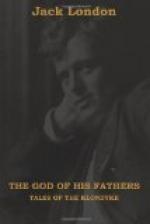but the trail, packed down fully a foot by the traffic,
was like a gutter. On either side spread the
blanket of soft snow crystals. If a man turned
into this in an endeavor to pass, his dogs would wallow
perforce to their bellies and slow down to a snail’s
pace. So the men lay close to their leaping
sleds and waited. No alteration in position
occurred down the fifteen miles of Bonanza and Klondike
to Dawson, where the Yukon was encountered.
Here the first relays waited. But here, intent
to kill their first teams, if necessary, Harrington
and Savoy had had their fresh teams placed a couple
of miles beyond those of the others. In the
confusion of changing sleds they passed full half the
bunch. Perhaps thirty men were still leading
them when they shot on to the broad breast of the
Yukon. Here was the tug. When the river
froze in the fall, a mile of open water had been left
between two mighty jams. This had but recently
crusted, the current being swift, and now it was as
level, hard, and slippery as a dance floor. The
instant they struck this glare ice Harrington came
to his knees, holding precariously on with one hand,
his whip singing fiercely among his dogs and fearsome
abjurations hurtling about their ears. The teams
spread out on the smooth surface, each straining to
the uttermost. But few men in the North could
lift their dogs as did Jack Harrington. At once
he began to pull ahead, and Louis Savoy, taking the
pace, hung on desperately, his leaders running even
with the tail of his rival’s sled.
Midway on the glassy stretch their relays shot out
from the bank. But Harrington did not slacken.
Watching his chance when the new sled swung in close,
he leaped across, shouting as he did so and jumping
up the pace of his fresh dogs. The other driver
fell off somehow. Savoy did likewise with his
relay, and the abandoned teams, swerving to right and
left, collided with the others and piled the ice with
confusion. Harrington cut out the pace; Savoy
hung on. As they neared the end of the glare
ice, they swept abreast of the leading sled.
When they shot into the narrow trail between the soft
snowbanks, they led the race; and Dawson, watching
by the light of the aurora, swore that it was neatly
done.
When the frost grows lusty at sixty below, men cannot
long remain without fire or excessive exercise, and
live. So Harrington and Savoy now fell to the
ancient custom of “ride and run.”
Leaping from their sleds, tow-thongs in hand, they
ran behind till the blood resumed its wonted channels
and expelled the frost, then back to the sleds till
the heat again ebbed away. Thus, riding and
running, they covered the second and third relays.
Several times, on smooth ice, Savoy spurted his dogs,
and as often failed to gain past. Strung along
for five miles in the rear, the remainder of the race
strove to overtake them, but vainly, for to Louis
Savoy alone was the glory given of keeping Jack Harrington’s
killing pace.




